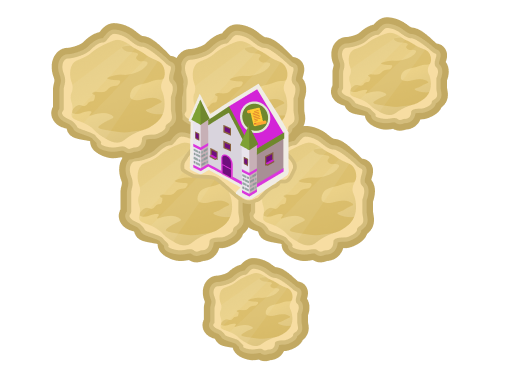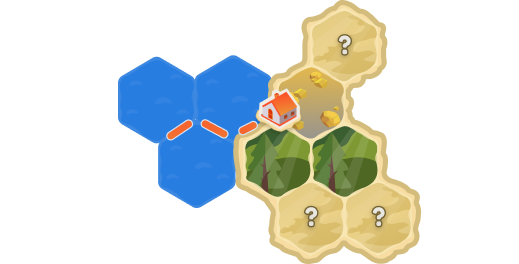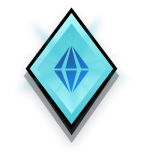Introduction
Objective
The first player to achieve the map victory points condition is deemed the winner. See the below to see all the ways players can earn victory points.
Number of players
Landover can be played with
2-4 players
Victory Points
Structure
Cost
Description
4
vpMetropolis
The first player to reach level 4 for any given culture is awarded a metro. When a player receives a metro, the player chooses one of their cities to place the metro on.
2
vpCityMay be built as an upgrade from the player’s existing villages
1
vpVillageMay be built on any land hex corner not adjacent to any other villages or cities and connected to the player’s own roads or boats
0
vpCity WallMay be built on existing city. Max 3 city walls per person. Increases safe hand size by 2 cards. Max 1 city wall per city.
0
vpRoadMay be built on any unoccupied land hex edge connected to the player’s own roads, villages, or cities
0
vpBoatMay be built on any unoccupied water hex edge connected to the player’s own boats, villages, or cities
Achievement
Description
2
vpLongest Route
As long as player has the longest route among all, players has +2 VP
1
vpIsland Explored
Building your first village on another island earns you an extra VP.
1
vpMerchant Token
Worth 1 VP for the user who controls it. A user must play a merchant token dev card to gain control of the merchant token at which point they gain 1 VP
1
vpVP Dev Cards
Each played Dev card gives player 1 VP
1
vpBarbarian Defender
For each successfully defended Barbarian attack the player with most military power gets 1 VP
Road Placements
If a hex tile’s edge is adjacent to both land and water, then the player may choose to build a boat OR a road there. However, you can’t connect a road to a boat or vice versa.
Boats Placements
If a hex tile’s edge is adjacent to two land tiles, then only a road can occupy that edge. If a hex tile’s edge is adjacent to two water tiles, then only a boat can occupy that edge.
Game process
Starting the Game
Numbers are “randomly” placed on each resource tile for the map chosen. Player order is randomly determined at the start of the game. Each player takes a turn placing 1 village at any starting hex corner and one road connected to that village. Player’s then go in reverse order taking turns placing one city at any starting hex corner and one road connected to that city.
All villages and cities must always be at least 2 corners away from all other villages and cities. Each time a player places a city, they receive one resource for each of the tile types their city is touching.
Turn Sequence
Dice are automatically rolled, unless player has an alchemist card (3 6-sided dice, one white and one red, and one event dice)
If a barbarian is rolled on the event dice, move the barbarian on the barbarian tracker. If this triggers a barbarian attack, carry out the attack per the “Barbarians” section below.
If a 7 is rolled, clear all catapult raids from the board. If any players have more cards in their hand then their safe hand size, half their hand is randomly discarded.
For all other rolls, players receive resources and commodities based on the numbers rolled. See production chart below.
Build, improve culture, buy military power, or trade in any order
Improving culture: All players start with culture levels of 0 for science, commerce, and politics. The cost to improve each is 1 commodity card of that type equal to the level you are improving to.
Buy Military Power
Building: Players may build additional structures at any time during their turn.
Trade Resources and Commodities
Carry out a raid
Resources
Commodities
Production Chart
Hex Tile Terrain
Village Production
City Production
Sheep
x1 Wool
Forest
x1 Wood
Mountain
x1 Ore
Field
x1 Wheat
Hills
x1 Clay
Gold
x2 Random
Landover Features & Details

Barbarians
Barbarian strength = Number of cities on the board
The barbarians will advance one square on the tracker each time a barbarian is rolled on the event dice. When the Barbarian reaches the end of the tracker, all players are attacked.
If the barbarian strength is greater than the players strength, then the barbarian’s win the attack and the player(s) with the least military power has a random city reduced to a village. If the player has no cities then no action is taken against them.
If the player strength is greater than or equal to the barbarian strength, then the barbarians lose the attack and the player with the greatest military power gains a military victory point. If two or more players tie for greatest military power then these players receive a random dev card.
As a result of the barbarian attack, regardless of the outcome, all players military power is reduced by one level.
Military Power
Players strength = Sum of all the player’s military power
All players begin the game with 0 military power. At any time on their turn player’s can choose to upgrade their military by spending 1 wool, 1 ore, and 1 wheat. Players may upgrade their military power to a max value of 5. For players whose political culture is level 3 or higher, their max military power is increased to 9. Military power serves two main functions: Defending barbarian attacks and carrying out raids on other players.
Defending Barbarian Attacks
If the barbarian attack is successfully defended, the player with the greatest military power gains a military victory point. If two or more players tie for greatest military power then these players receive a random dev card. If the barbarian attack is successful, the player(s) with the least military power has a random city razed to a village. If the player(s) has no cities then no action is taken against them. After each barbarian attack, all players military power is reduced by 1.
Raids
Players with a military power of 1 or more may carry out one raid each turn. Carrying out a raid reduces your military power by 1. The raiding player chooses a tile adjacent to any opponent’s villages or cities and places their catapult on that tile. If their own catapult was already on another tile, it is moved to the raiding location of the new tile. Players cannot raid a tile that already has a catapult on it.
If there are multiple players on the chosen tile, the player chooses which player he is raiding. The raiding player steals one random card from the chosen player. Any tiles with catapults on them are “dead” and do not produce resources or commodities. All catapults are removed from the board when a 7 is rolled.

Immunity
Game creators can set a VP level at which all players at or below this amount are immune from raids. Any tile next to an immune player (marked with a blue shield) can’t be raided with a catapult.
In addition, any time a raid is cleared from a tile, that tile becomes immune from raids for the duration of the game.

Merchant Token
The player placing the token chooses a resource tile adjacent to any one of their cities or villages to place it on. While in possession of the token, the player may trade resources 2:1 for the resource it is placed on. For example, if John owns the merchant token and has it placed on a wheat tile, he may trade wheat 2:1 for any other resource or commodity.
The merchant token is worth 1 VP for the user who controls it. There is only one merchant token in the game and it starts off not in play. A user must play a merchant token dev card to gain control of the merchant token at which point they gain 1 VP (and if there was a player previously in control of the merchant token, that player loses 1 VP).

Culture
There are three types of culture in Landover: Science (green/paper), Commerce (yellow/cloth), and Politics (blue/coin). By developing culture, players increase their chance of drawing dev cards. At the start of each turn, if the event dice rolls a green, yellow, or blue key, all players whose culture level for that category is higher than or equal to the number shown on the red dice is given a dev card. Any players already holding 5 dev cards do not receive a dev card. Victory point dev cards do not count towards the max 5.
To improve your culture, you must upgrade it using the associated commodity defined above. The cost to upgrade is always one additional commodity than whatever the current level is. So upgrading science from 0 to 1 costs 1 paper. Upgrading politics from 3 to 4 costs 4 coins. The max culture level for all culture types is 5. For each type of culture, reaching level 3 unlocks a special ability for the rest of the game.

Metros
There are 3 total metros (worth 2 VPs each) available in the game, one for each type of culture. The first player to reach level 4 for any given culture is awarded a metro. When a player receives a metro, the player chooses one of their cities to place the metro on. Any city with a metro upgrade cannot be destroyed by a barbarian attack. If a player achieves level 4 after another player has already achieved level 4, they do not receive the metro.
However, if another player achieves level 5 before the other player who already has the metro of that type, then the metro is stolen away from the other player resulting in a transfer of those 2 VPs. The first player to reach level 5 for any given culture type retains the metro for the rest of the game and cannot lose it. The only reason for any other player to continue developing that culture type further would simply be to get the level 3 ability or increase their chances of getting a development card.

Longest Route
Longest Route is awarded to the player with the longest continuous route from end to end of roads and boats with a count of 5 or more. The route can contain your own villages or cities but not an opponent’s. To take longest route away from another player, you must build a route that is at least one longer than theirs (by building more roads or boats or interrupting their route with a village). If a route forks, the longest fork is counted. No road or boat may be counted twice (no circular routes).

Port Authority
Port Authority is awarded to the player with the most harbors (ports) as long as they have a minimum of 3. To take Port Authority away from another player, you must settle on one more harbor than the player who currently has the most. Harbors do not need to be unique (3 wood harbors is ok). The player who is the Port Authority gains an additional +2 Victory Points.

Rankings






The current Landover ranking system comprises six tiers, to indicate the general skill level of players. Tiers are split into five divisions each, numbered from 1 (I), the lowest tier, through 5 (V), the highest tier. Players within each division are ranked using a point system called Ranked Points (RP). When a player reaches 100 RP they are promoted to the next division.
After division 5 they are promoted to the next tier. Players can also get demoted to a lower division or tier when their RP reaches 0 and they lose.
Players can monitor their League standings in their profile or on the ranked screen.
At the end of the game, your performance gets analyzed and you'll win/lose Ranked Points depending on how you did! The amount earned or lost depends on all the players relative skill levels in the game and how many victory points each player earned in the game.

Seasons
Landover seasons are a way for players to compete for additional awards throughout the course of a 3 month season, all corresponding to the seasons of the year: Autumn, Winter, Spring and Summer. Every game you play, ranked or casual, earns you season points so long as there are no bots in the game.

Jan 1 - March 31

April 1 - June 31

July 1 - Sept 31

Oct 1 - Dec 31
At the end of each season, the top 3 players will be awarded a unique badge for that year and season. Any other players who participated and played at least 10 games in that season will be awarded a participation badge unique to that season. These badges will be displayed on your profiles.
Multiplier = (Numplayers / 2) * (Numplayers - PlaceFinish / (Numplayers - 1)) Points = EarnedVPs * Multiplier; Examples: 1st place in 2 player game, earned 15 VP. Points = 15
2nd Place in a 2 player game, earned 14 VP Points = 0
1st place in 3 player game, earned 21 VP. Points = 21* 1.5 = 31.5
2nd Place in 3 player game, earned 11 VP. Points = 11 \ *(1.5 * .5) = 8.25
1st Place in 8 player game, earned 21 VP. Points = 21 * (4) = 84.
2nd place in 8 player game, earned 19 VP. Points = 19 \ *(4 * 6/7) = 65.14

Development(Dev) Cards
The table below shows all the various dev cards in the game.
Commerce
Name
Qty
Description
Commercial harbor
x2
Master Merchant
x2
Merchant
x6
Merchant Fleet
x2
Resource Monopoly
x4
Commodity Monopoly
x2
Science
Name
Qty
Description
Alchemist
x2
Crane
x2
Inventor
x2
Irrigation
x2
Medicine
x2
Mining
x2
Printer
x1
Road
x2
Military
x2
Politics
Name
Qty
Description
Siege
x2
Bishop
x2
Constitution
x1
Deserter
x2
Vandal
x2
Diplomat
x2
Raze
x2
Spy
x3
Wedding
x2
Definitions:
Hex Corners — Each hexagonal tile (hex tile) in the game has 6 corners. A hex corner is any one of the 6 corners on a hex tile.
Starting Hex Corners — Any hex corner where a village or city can legally be placed at the start of the game. The hex corner must be adjacent to a land hex tile and must NOT be adjacent to any mystery hex tiles.
Safe Hand Size — The maximum number of cards a player can safely hold in their hand. At the start of the game all players safe hand size is 7. For each city wall they build, it increases their safe hand size by 2. Since a max of 3 city walls can be built per player, the maximum safe hand size is 13. Whenever a 7 is rolled, if players are holding more cards than their safe hand size, half of their cards are randomly discarded.
Barbarian Tracker — Every 7 barbarian rolls on the event dice triggers a barbarian attack. The barbarian tracker is the UI element that shows exactly when the attack will occur.
Mystery Tiles — A mystery tile is a tile whose resource type and number is unknown to all players at the start of a game. Certain maps contain tiles which are unrevealed to start the game and only become revealed once a road (or boat) touches that tile.
Catapult — Each player possesses one catapult that matches their player color. The catapults are used to designate raids on the board and prevent tiles from producing resources. All catapults are removed from the board when a 7 is rolled.

